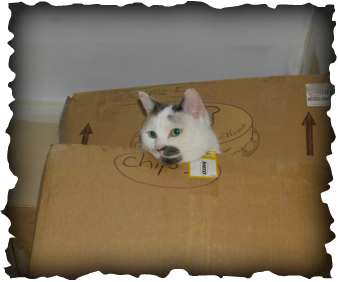Contrary to common belief
 Korrigan Schtroumpfette at the top of a cardboard stack
Korrigan Schtroumpfette at the top of a cardboard stack
- It is not a genetic disease. In fact, genetic disease constitutes a handicap for the animal or the person. But, this is NOT the case for Munchkin, its short legs absolutely aren’t a handicap. It is a mutation, as well as the loss of hair for the Sphynx. It’s the result of a spontaneous gene mutation.
- These short legs don’t affect the speed or agility of the cat and don’t prevent its mobility: running, climbing or jumping are as easily as any other cat.
- If the genetic mutation responsible for causing short legs is often called achondroplasia (a form of dwarfism), it has never been proven that this physical trait is due to a mutation of the gene located at the same locus as the one that causes dwarfism in man. In addition, achondroplasia is typically associated with an enlarged head, which is not the case of Munchkin. Only legs are smaller than normal. Adult, it measures the size of a normal cat gutter.
- The Munchkin doesn’t suffering from a lack of growth. At birth, its legs are already shorter than those of its brothers and sisters called "non-standard" (long legs) and its growth is proportional.
- This mutation doesn’t alter its health or its life: it’s a very healthy cat. No disease specific about the breed have occurred since the birth of the first Munchkin in 1983. The Munchkin can live up to twenty years if the living conditions are good.
- This mutation doesn’t affect its balance. The Munchkin isn’t prone to spinal problems like lumbar pain, slipped discs, or premature degeneration of the spinal column, as opposed to dachshund reached of chondrodysplasia.
- The Munchkin isn’t exclusively an indoor cat: its short legs prevent it to defend itself or run fast, especially because Munchkin can climb better than most other cats.
© Korrigan Cattery 2016-2017 - Toute reproduction interdite
